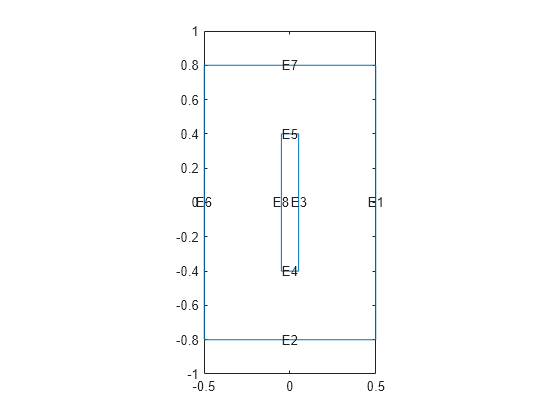linearizeInput
linearizeInput will be removed.
Description
linearizeInput(
adds inputs for the boundary condition, constraint, load, or source with the label
model,labeltext)labeltext. In the linearized model, the input value
u = 1 corresponds to a unit boundary condition acting on the entire
region specified by labeltext. In other words, simulating the
linearized model with the input value u(t) = 25 is
equivalent to setting the boundary condition value to 25 in the thermal or structural model
in Partial Differential Equation Toolbox™. For more information, see Algorithms.
For a structural analysis model, the following boundary conditions, constraints, and loads can become inputs of the linearized model:
A structural boundary constraint. Use the
structuralBCfunction with theConstraintargument.A displacement or a displacement component on the boundary. Use the
structuralBCfunction with theDisplacement,XDisplacement,YDisplacement, orZDisplacementargument.A structural boundary load. Use the
structuralBoundaryLoadfunction with thePressure,Force, orSurfaceTractionargument.A structural body load. Use the
structuralBodyLoadfunction with theGravitationalAccelerationargument.
The boundary conditions, loads, or constraints with x-, y-, and z- components produce one input channel per component.
For a thermal analysis model, the following boundary conditions and sources can become inputs of the linearized model:
A temperature or heat flux on the boundary. Use the
thermalBCfunction with theTemperatureorHeatFluxargument.An internal heat source. Use the
internalHeatSourcefunction.
Each selected condition or source produces a single scalar input in the linearized model.
To make a condition, constraint, load, or source available as a linearization input, always label it upon creation. For example, specify an internal heat source for a thermal model as follows:
internalHeatSource(thermalmodel,25,"Label","HeatSource");
The remaining boundary conditions are set to zero for linearization purposes, regardless
of their value in the structural or thermal model. Ensure that you label all nonzero
boundary conditions and pass them as inputs using linearizeInput.
Use linearizeInput and linearizeOutput
together with the linearize function
to extract sparse linear models from structural and thermal models.
Examples
Input Arguments
Output Arguments
Algorithms
The linearize function constructs a linear model whose inputs are a
subset of the boundary conditions, loads, or sources applied to the thermal or structural
model in Partial Differential Equation Toolbox and whose outputs are the resulting values at the selected DoFs. For example, if
you designate the heat source
internalHeatSource(model,25,"Face",2,"Label","heatSource")
as a linearization input
linearizeInput(model,"heatSource")
and designate the temperatures on face X as linearization
outputs
linearizeOutput(model,"Face",X)
X.tlist = 1:10; u = repmat(25,size(tlist)); ysp = lsim(linsys,uLoad,tlist);
Note that loads and boundary conditions not included as linearization inputs are assumed to be zero in the linearized model regardless of their values in the structural or thermal model in Partial Differential Equation Toolbox. Simulation results can differ in this case.
